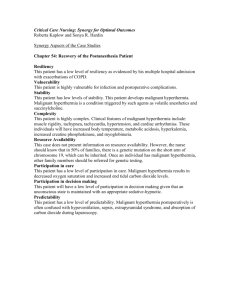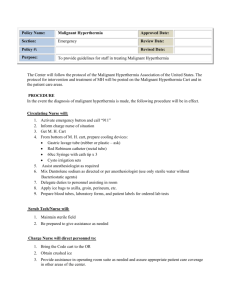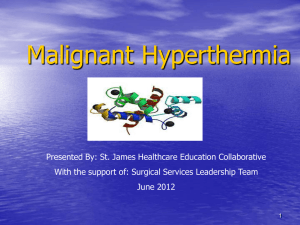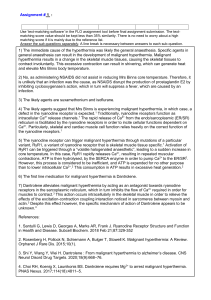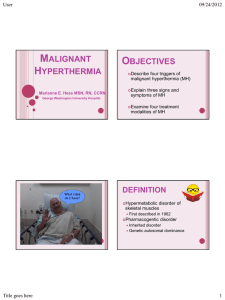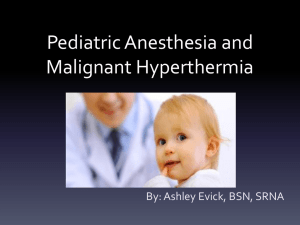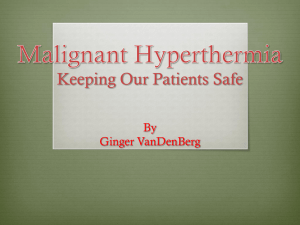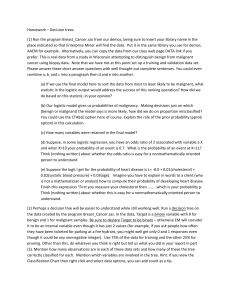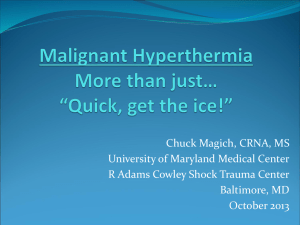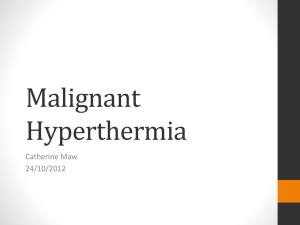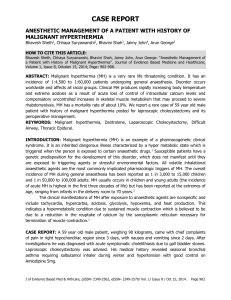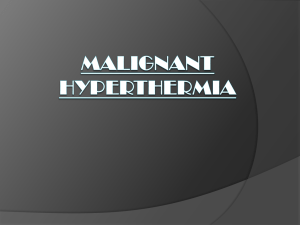Malignant Hyperthermia (MH)
advertisement
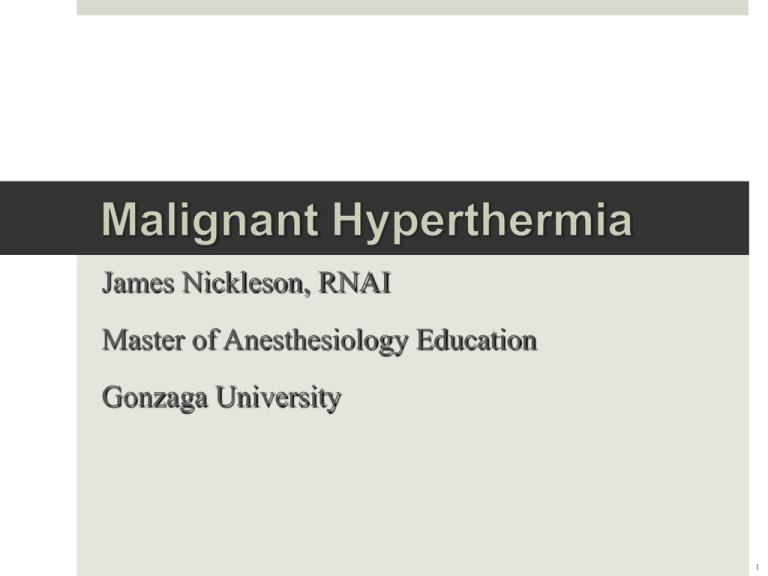
James Nickleson, RNAI Master of Anesthesiology Education Gonzaga University 1 Physiology and epidemiology Clinical manifestations Differential diagnosis and treatment Case review MH resources 2 Inherited disorder of skeletal muscle Problem w/ reuptake of intracellular Ca2+ Exact cause uncertain Ryanodine receptor Disease inheritance is autosomal dominant 3 Definite association: central core disease Possible association: Duchenne, Becker, King-Denborough, other myopathies Coincidental association: neuroleptic malignant syndrome, SIDS, Lymphomas, and Heat Stroke 4 Frequency 1:3,000 - 1:60,000 anesthetic cases Approximately 600 cases per year in U.S1 Increased incidence in young adult males 1:100,000 hospital discharges complicated by MH 5 Muscle Contracture Test Caffeine Halothane Contracture Test(CHCT) Gold Standard Genetic Testing Ryanodine receptor (RYR1 Gene) Primary genetic focus DNA blood test or biopsy MH Muscle Biopsy Center 6 MH Triggers Potent volatile anesthetics Sevoflurane Desflurane Isoflurane Depolarizing muscle relaxants NOT MH Triggers Nitrous oxide IV induction agents Non-depolarizing muscle relaxants Opioids Succinylcholine 7 Specific Muscle rigidity* Increased CO2 production Marked temperature elevation Rhabdomyolysis Non-Specific Tachycardia Tachypnea Acidosis (respiratory; metabolic) Hyperkalemia 8 Insufficient anesthesia or analgesia Insufficient ventilation or FGF Anaphylactic reaction Pheochromocytoma Cerebral ischemia Neuromuscular disorders Procedural causes Malignant neuroleptic syndrome Thyroid crisis 9 Stop triggering inhalation agents/succinylcholine Hyperventilate high flow 100% O2 Dantrolene 2.5mg/kg push, repeat prn Continue monitoring & interventions Treat hyperthermia, acidosis, and arrhythmias 10 Muscle relaxant Indications The only specific and effective treatment for MH Neuroleptic malignant syndrome, muscle spasticity, serotonin syndrome, and 2,4-dinitrophenol poisoning Drug Interactions CCBs, NDNMB, CNS depressants & benzodiazepines 11 Shut down/disable vaporizers Flow O2 > 10L/min for 20 minutes through machine and ventilator Change CO2 absorbent Use non-trigger agents and methods Monitor for early signs of MH 12 34 year old male Right ankle ORIF with iliac bone graft Past medical history & medications HTN, GERD, shoulder reconstruction Lisinopril, hydrocodone, marijuana Anesthesia plan = GA + regional 13 Site specific policy Malignant Hyperthermia Cart MHAUS Malignant Hyperthermia Association of the United States @ 1-800-MH-HYPER www.mhaus.org 14 Disorder with intracellular Ca2+ effecting skeletal muscle Triggered by inhaled anesthetics & succinylcholine Specific and non-specific clinical signs Definitive treatment with Dantrolene 15 Brady, J.E., Lena, S.S., Rosenberg, H., Li, G. (2009). Prevalance of malignant hyperthermia du to anesthesia in new york state, 2001-2005. Aneshtesia & Analgesia. 109:1162-1166. Glahn, K.P.E, Ellis, F.R., Halsall, P.J., Muller, C.R., Snoeck, M.M.J., Urwyler, A., & Wappler, F. (2010) Recognizing and managing a malignant hypthermia crisis: guidelines from the European Malignant Hyperthermia Group. British Journal of Anaesthesia. 105 (4):417-420. Rosenburg, H., Brandom, B.W., & Sambuughin, N. (2009). Malignant Hyperthermia and Other Inherited Disorders. In P.G. Barash, B.F. Cullen, & R.K. Stoelting. (Eds.) Clinical Anesthesia (6th ed., pp. 598-619). Philadelphia: Lippincott Williams & Wilkins Stoelting, R., & Hiller, S. (2006). Handbook of Pharmacology & Physiology in Anesthetic Practice (2nd Ed). Philadelphia: Lippincott Williams & Wilkins Torpy, J., Lynm, C., Glass, R.M. (2005). Malignant Hyperthermia. JAMA; 293 (23): 2958 16
